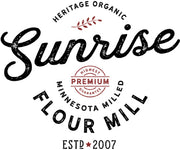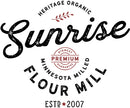Sourdough seems like it’s everywhere these days. That’s a good thing, right? It’s been proven that sourdough bread is better for us. It’s a fermented food and those contain higher levels of vitamins, minerals, and antioxidants than other breads. It also contains lower levels of phytate. This allows your body to absorb nutrients more easily than those in regular bread.
Some studies show sourdough bread acts as a prebiotic, which means that the fiber in the bread helps feed the “good” bacteria in your gut. These bacteria are important for maintaining a stable, healthy digestive system.
Unlike “grocery store” bread, sourdough has so much flavor. I know not everyone likes a sour flavor. It doesn’t have to have one. The Sunrise starter is quite mild, but for those of you who like sour, it can be made that way.
Because sourdough is so popular, everyone is jumping on the bandwagon. Beware, not all sourdough really is what it claims to be. Sometimes it’s known as “sour faux”. Bakeries and restaurants have gotten much more sophisticated in their ingredient wording that it might sound legit.
Become a label reader or if you’re in a restaurant or bakery don’t be afraid to ask for clarification. Genuine sourdough will have 4 ingredients - flour (hopefully heritage wheat), water, and salt. The fourth ingredient could be listed as natural yeast, sourdough starter or naturally leavened.
.
It should not contain vinegar, yeast (or baker’s yeast), sugar (in any form including barley malt), baking powder or soda, acetic acid, added vitamins and minerals- if you see these ingredients, it's not real sourdough bread. Additionally, you will never see “contains a bioengineered food ingredient” on a real sourdough product. It’s simply someone slapping a trendy label on a deceptive product.
When you're looking at labels and there are ingredients you don’t know about, look them up. If you read about an item online, make sure the ingredients on the actual products match what it says online. By law, the ingredients in a product have to be listed on the label in descending order. A website isn’t held to that same standard. For example, they could list the number of ingredients. If it’s just a few, you might think it’s what you’re looking for. When you read the actual label there might be that number of ingredients but check out what they really are. Remember, if it says “yeast” it's not sourdough.
Darrold has noted that a skilled baker can use baker’s yeast to make bread with qualities that imitate those often associated with sourdough, such as a crisp, chewy crust, and open crumb (holes)... but that doesn’t make it sourdough nor does it have the health benefits.
It can be exhausting to eat well but it’s worth it in the end for your health. More people are becoming aware of the importance of nutritious eating. There are many resources out there to help, including us :)
All for now,














